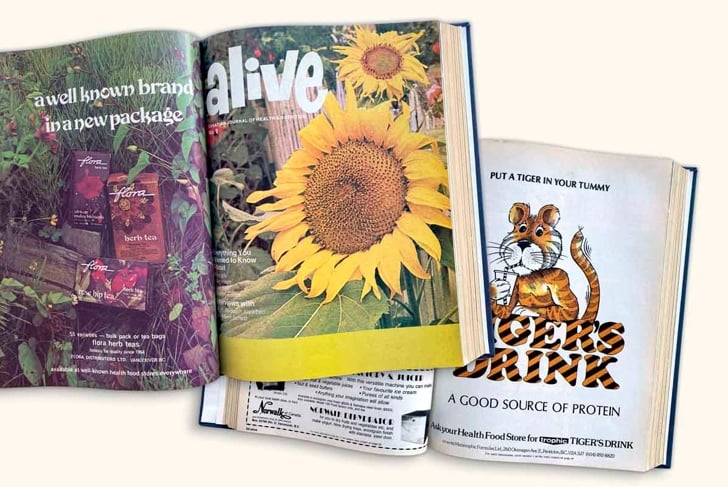
In 1975, Siegfried Gursche, a German-born bookstore owner and herbalist, was at a meeting of the Canadian Health Food Association (CHFA). Members were discussing a proposal to launch a natural health newsletter, and when they decided to put the idea on pause, Gursche sprang into action.
With a few folds of his paper placemat and flicks of his pen, he mocked up a magazine that he saw fulfilling an immediate need for the public to learn more about natural health—a publication which, 50 years later, continues to inspire millions of community members in an ever-evolving natural health and wellness landscape.
Humble beginnings
In an era when the concept of natural health and wellness was relatively new and fighting for legitimacy, alive’s first years were marked by scrappiness and tenacity. Within two weeks of Gursche’s paper mock-up, 30,000 copies of the first issue of alive were rolling off the press.
In his Vancouver bookstore, Gursche had sold books related to natural health and nutrition, and eventually started importing herbs that his customers were interested in. The birth of alive, and the successive release of companion products like alive Academy and alive Books, offered the public a trusted source for information on what was then, in North America, a nascent field.
Lucky number 5 … 00!
In June 2024, alive magazine published its 500th issue.
alive today
Gursche would go on to publish the magazine for 30 years before retiring in 2005. Now under the umbrella of Alive Publishing Group (APG), alive has continued to thrive. It published its 500th issue in 2024, and counts over 1,500,000 monthly readers across North America, with 1,800 natural health retailers distributing the magazine.
“alive is a critical cog in the wheel of the natural health industry,” says APG publisher and CEO Ryan Benn. Benn explains how alive interfaces with consumers, retailers, and manufacturers thanks to its unique publishing model, where retailers acquire alive and invite their customers to pick it up at no cost.
From a niche area of interest, the Canadian natural health products market has grown to US$6.2 billion in 2023 and is forecasted to reach up to US$12.8 billion by 2033. This rise means that alive is at the forefront of a rapidly growing industry, and the publication takes its leadership position seriously.
“Trustworthiness, storytelling, and community are at the heart of what we do,” says Benn. “They may sound like buzzwords, but at alive, we truly live by these principles.”
Get to know Alive Publishing Group
Alive Publishing Group’s full suite of products includes the following:
- alive Canada
- alive USA
- delicious living
- alive Academy
- alive.com
- deliciousliving.com
- alive Newsletter
- alive Workplace Wellness
- alive Connect
- alive Listens
- thrive
- alive Awards
- delicious living Awards
- alive Executive Summit
- CNHR (Canadian Natural Health Retailer magazine)
A source you can trust
From its inception, readers have considered alive a trusted source when it comes to natural health and wellness, and for good reason—all alive content is subject to rigorous editing and fact-checking. This rigour was critical in the pre-digital age when it was harder for consumers to access information on natural health solutions, but is equally important in 2025, as the internet and social media platforms have exposed us to more potentially dubious information than ever before.
Stories that you won’t forget
While alive prioritizes credible, accurate information, vice president of content Tracy Peternell says its lasting success comes from delivering stories in an engaging, accessible way.
She adds that alive builds strong reader connections through human-centred storytelling and trusted writer relationships. “Regular writers begin to feel like friends who always have interesting and informed perspectives to offer,” she says. “You want to open the magazine and have a coffee with them.”
Another key factor in alive’s success is its distinctive visual identity, overseen by creative director Scott Yavis. Much of the magazine’s imagery, particularly for its recipes, is produced in-house—an intentional choice that preserves alive’s unique aesthetic in an era dominated by stock and AI-generated visuals.
Children’s natural health trends, then and now
In August 1975, alive featured a column called “A Child’s Garden of Health,” offering tips like sneaking spinach into kids’ meals. From these classic negotiations, parents eventually started buying children’s multivitamins for all-in-one support.
Now, there’s been a shift to a wide range of children’s natural health products, including kid-friendly versions of melatonin and magnesium for sleep, omega-3s for brain development, and iron for athletic performance. Many of these supplements come in chewable or gummy formats.
A community at the heart of it all
Through alive magazine and products like alive Workplace Wellness, a boutique digital version of alive distributed internally to over 400 corporate wellness partners, alive has worked to cement a community around its inclusive vision of natural health and wellness. Yavis notes that it seems almost everyone has a story to tell about alive; Benn says that he often receives calls from readers who discover that their parents have archived every issue of the magazine.
“Positive emails [from] are so encouraging and remind me of how many people benefit from what we do,” says Peternell. “We aim to keep growing, to keep reaching more people each issue.”
A changing landscape
The natural health and wellness landscape is dramatically different from when those first issues of alive were printed back in 1975. The industry has grown impressively, and in general, interest in natural health and wellness products is on the rise, with half of Canadians viewing natural products as a valuable complement to Western medicine.
Barb Brennan, founder of Honey & Ginger in Dartmouth, Nova Scotia, says, “Customers have confidence in the information they read in alive,” a sentiment still shared by alive’s legions of dedicated readers.
Meanwhile, many trends have come and gone. While the August 1975 issue of alive features “beauty” and “weight loss” products, nowadays, the focus has shifted more toward holistic well-being.
As more Canadians enter their senior years, interest is growing in products that support healthy aging—especially those targeting heart health, bone density, and cognitive function. As research has caught up on the wonders of the microbiome, probiotics and other immune- and gut-supporting supplements have become more popular. Natural remedies for perimenopause and menopause symptoms are also gaining traction.
While the industry’s focus used to be mainly on physical health, there has been a massive uptick in consumer interest in supplements to support mental health and reduce stress, particularly post-COVID-19.
Making the world a greener place
Alive Publishing Group is working with nature-based solutions provider veritree to offset its carbon emissions, having planted 630,863 trees so far.
A beloved Canadian brand
The only constant is change, but through it all, alive aims to be there for its community. Says Brennan, “[alive] is a trusted advisor to many and, because of the education the magazine provides, it gives our customers reassurance the products they buy are relevant and correct to help with their specific needs. If they see a product in the magazine, it gives them peace of mind ... [that] will help improve their health.”
On a personal note, alive has long held a special place in my heart. I first joined the alive team as a wide-eyed editorial intern in 2013, and from day one, I was struck by the team’s focus and shared commitment to health and wellness.
Even as life has taken me down different paths, alive continues to be a special part of my story—as it has been for millions of other Canadians inspired by its content over the last 50 years.
Top recommended supplements, then and now
Here are some key supplements that alive has featured over the years.
|
Supplement |
Health benefits |
|
vitamin C |
alive’s August 1975 issue features an advertisement for mango-flavoured vitamin C supplements, which, just like today, were understood to play a role in supporting a strong immune system. |
|
vitamin D |
Some of alive’s first issues were concerned with fighting regulations that would have prevented vitamin D from being sold over the counter, but we know now that safe vitamin D supplementation can help promote bone health and fight inflammation. |
|
magnesium |
Magnesium is an essential factor in over 300 biochemical processes in the body, and it may play a role in mediating diabetes, headaches, and PMS. |
|
omega-3 fatty acids |
A type of polyunsaturated fat, omega-3 fatty acids may help to fight inflammation, strengthen cognitive function, and reduce the risk of heart disease. |
|
probiotics |
Since the early 2000s, probiotic supplements and probiotic-based foods have surged in popularity—for good reason, given their potential to improve or restore our gut flora, which in turn can promote better overall health. |
This article was originally published in the August 2025 issue of alive magazine.





